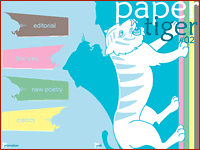 |
I just discovered the following review by Edward Picot of Papertiger, a CDRom journal of poetry and art published out of Brisbane, Australia, that has a really nice paragraph on my Flash piece The Dreamlife of Letters.
I think he's totally spot on (of course, because he likes it!), right down to the last bit about it not being "avant-garde" or the issue with newness. It's for this very reason that, when asked to produce statements on "digital poetry" I rarely if ever write about what one is able to do with text in motion, etc. I've never been very convinced that a resurgence of "avant-garde" activity was imminent due to the availability of digital technology. But I'll take the "mastery" and even "form of classicism" that Picot mentions -- it's what one can aspire to with the extraordinary control that software and coding often provides.
Yadda yadda -- I'm a bit too tired right now to really divagate on these themes. Sorry for the my-own-horn-tooting, just not much else for the blog these days.
trAce Online Writing Centre - Review

"The last section is titled "Flash", and consists of four pieces of Flash poetry. None of them is non-linear, and none of them is interactive. The most interesting is The Dream Life of Letters by Brian Kim Stefans - a kind of fantasy on the letters of the alphabet, showing a list of words that start with each letter in turn, all animated in various ways. The whole sequence is played out within the confines of an orange square, and all the words are shown either in black or white, or a mixture of the two. Black or white lettering on an orange square works very effectively as a visual statement, as the Orange mobile phone company has discovered, so Stefans has this in his favour from the start. He doesn't use any sound effects, so his letters and words float and dance around the screen in silence, which enhances the dreamlike atmosphere of the piece. He is constantly inventive, frequently witty and thought-provoking: numerous small white examples of the word "am" go floating down the page early on in the piece, for example, with only one black "am" amongst them, which seems to say something about individuality. "Conventional", "cunt" and "curse" follow one another in quick succession around a circling C - the prim is replaced by the obscenely vulgar, and the third word, "curse", both describes "cunt" as a swear-word, and acts as a colloquialism for menstruation. There is a lot of material about gender and sexuality here, as Stefans suggests in his introduction to the piece, but for me its fascination lies primarily in how it works as a piece of design. Words and letters drift and drip down the square, or bounce, or float upwards, or slide across from one side to the other, or fade in and out. They can be aligned to the right, to the left, to the top or bottom. They can be large or small. Sometimes they chase each other, sometimes they are transformed into each other, and sometimes a formation made by one word is broken by an onslaught from another. This isn't avant-garde art: The Dreamlife of Letters is not trying to be radically different from anything we have ever seen before. On the contrary, the austerity and simplicity of its layout suggest a form of classicism, a purifying and restatement of themes and formats that have already been attempted more than once. What we are being asked to admire here is not newness but mastery within a given medium: not invention but inventiveness."
Posted by Brian Stefans at January 27, 2004 01:01 PM | TrackBack